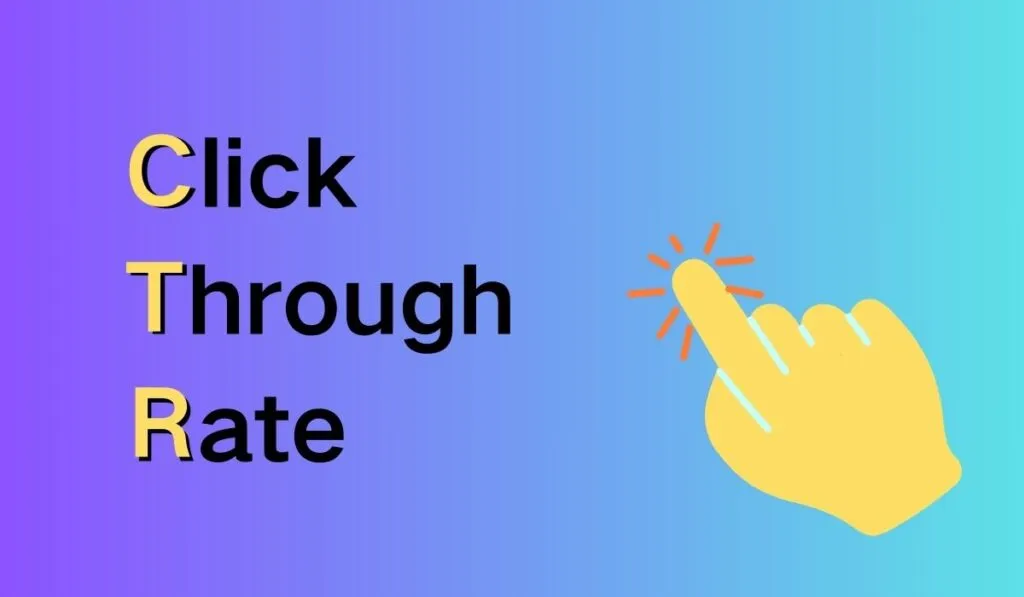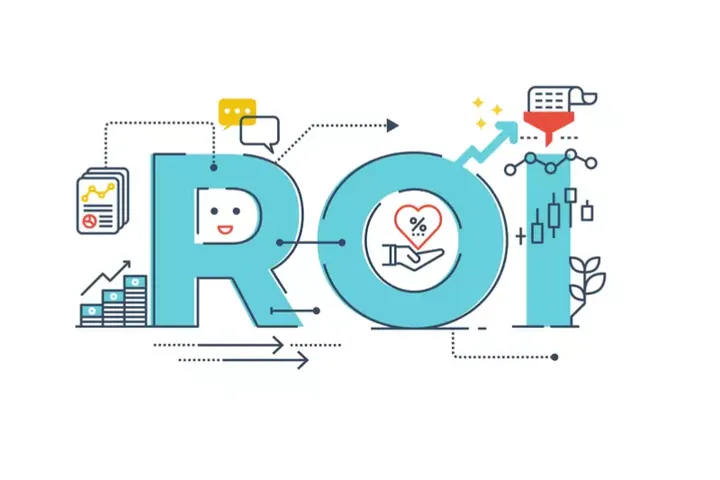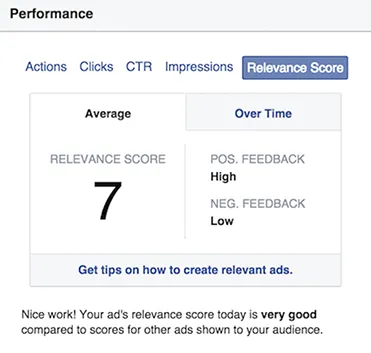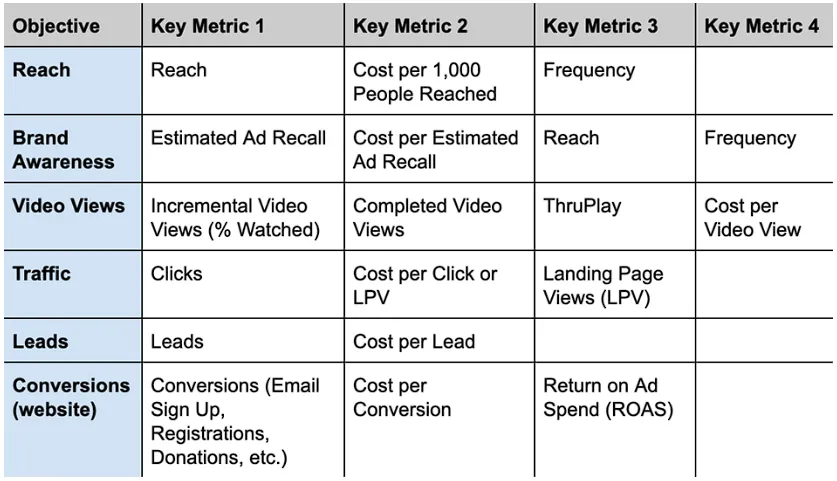12 Facebook Advertising KPIs You Need to Track (2024)
What are Facebook Advertising KPIs?
Facebook Advertising Key Performance Indicators (KPIs) are a set of data points that measure the effectiveness of your advertising campaigns. They help advertisers understand their ads' performance and make data-driven decisions to improve the efficiency and effectiveness of their ad spending, ensuring the best use of advertising budgets and achieving business goals.
Why Set Facebook Advertising KPIs?
Measuring Facebook Advertising KPIs offers advertisers several benefits, including:
1. Optimizing Advertising Spend and Improving ROI: By tracking KPIs, advertisers can identify the most and least effective ad placements, adjust budget allocations, reduce waste, and effectively manage ad spending to achieve more conversions at a lower cost.
2. Enhancing Ad Performance: KPIs provide quantifiable data to evaluate ad performance, helping advertisers understand how to improve key metrics like click-through rates and conversion rates.
3. Gaining Customer Insights: KPIs assist in better understanding the behaviors and preferences of the target audience, revealing deeper insights into customer behavior, and enabling the creation of more targeted advertising content, which is crucial for building stronger customer relationships and enhancing customer satisfaction.
4. Supporting Decision-Making: KPIs provide data support for assessing the effectiveness of long-term advertising campaigns, enabling fact-based decision-making rather than relying solely on intuition.
5. Gaining a Competitive Edge: Monitoring KPIs in real-time allows advertisers to quickly respond to market changes and adjust advertising strategies to gain an advantage in the competitive market.

Main Facebook Advertising KPIs
Click-Through Rate (CTR)
A key metric for measuring the effectiveness of Facebook ads, indicating the ability of ads to attract user clicks. Specifically, CTR shows the proportion of users who actually clicked on the ad out of the total number of ad impressions. This is a crucial performance indicator as it directly relates to the ad's ability to attract the attention of the target audience.
Calculation Method
CTR = (Number of Clicks / Number of Impressions) × 100%
- Clicks: The number of times users actually click on the advertisement.
- Impressions: The total number of times the advertisement is displayed to users, regardless of whether they click or not.
Importance
- Reflects User Interest: A high CTR indicates that the ad content is highly relevant to the target audience and has successfully attracted their attention.
- Quantifies Ad Effectiveness: CTR provides a quantifiable metric to help advertisers assess the appeal of their ad creatives, designs, and copy.
- Cost-Effectiveness Analysis: A high CTR usually means a lower cost per click, which is crucial for advertisers with limited budgets.
- Optimizes Ad Strategy: By analyzing CTR, advertisers can identify which ads perform well and which need improvement, optimizing their ad placement strategy.
- Predicts Conversion Potential: While CTR does not directly equate to conversion rate, ads with higher CTRs are generally more likely to result in higher conversion rates.
How to Optimize This Metric?
- Precise Targeting: Ensure that the advertisements reach the audience most likely to be interested.
- Compelling Ad Creative: Use captivating images, videos, or copy to attract users.
- Clear Value Proposition: Make sure the ad clearly communicates the value of the product or service.
- Test and Optimize: Conduct A/B testing to compare the effectiveness of different ad elements (such as headlines, images, and calls to action) and optimize the best-performing elements.

Conversion Rate
Another key metric for measuring the effectiveness of Facebook ads, indicating the proportion of users who complete a specific target action, such as purchasing a product, registering an account, downloading an app, or completing a form, after clicking on the ad. Conversion rate is crucial for assessing the ultimate effectiveness of an ad, as it directly relates to the actual business value it brings.
Calculation Method
Conversion Rate = (Number of Conversions / Number of Clicks) × 100%
- Conversions: The total number of times users complete a desired action after clicking the ad.
- Clicks: The total number of times users actually click on the ad.
Importance
Conversion rate measures the ultimate effectiveness of an ad, indicating whether it successfully prompts users to complete the desired action.
- Direct Reflection of Business Impact: Conversion rate reflects the actual business outcomes driven by the ad, such as sales or registered users.
- Measuring Ad Goal Achievement: Through the conversion rate, advertisers can understand how well a specific ad campaign is performing in achieving its set objectives.
- Optimizing Ad Placement: Conversion rate provides a basis for optimizing ad placement, helping advertisers identify which ad elements are more effective in driving user action.
- Cost-Effectiveness Analysis: A high conversion rate typically means a lower cost per conversion, which is crucial for controlling the ad budget and improving return on investment (ROI).
- Long-Term Value Assessment: Conversion rate helps evaluate the long-term value of users, such as through analyzing repeat purchases or customer lifetime value (LTV).
How to Optimize This Metric?
- Precise Targeting: Ensure the ad reaches the target audience most likely to convert.
- Optimize Landing Page: Make sure the landing page users reach after clicking the ad is highly relevant to the ad content and designed for easy user interaction.
- Clear Calls to Action: Both the ad and the landing page should feature clear and compelling call-to-action (CTA) buttons or copy.
- Test and Optimize: Conduct A/B testing to compare the effectiveness of different ad elements (such as headlines, images, and CTAs) and optimize the best-performing elements.
- User Feedback: Collect and analyze user feedback to understand their needs and preferences, and identify why some users did not complete the conversion.
Reach
A key performance indicator for measuring the reach of Facebook ads, indicating the total number of unique users who have seen the ad within a specific period. Unlike impressions, reach focuses on the number of different users exposed to the ad, rather than the total number of ad displays.
Calculation Method
The calculation of reach is typically automated by the Facebook advertising platform, and advertisers can view it directly in the Ads Manager. Reach does not require manual calculation because Facebook tracks and provides this data. Even if a user sees the same ad multiple times, they are counted as a unique user only once. For example, if an ad is shown 1,000 times in one day but is seen by only 300 different users, the reach of the ad is 300.
Importance
- User Reach: Reach directly reflects how many unique individuals the ad has been able to touch.
- Market Penetration: High reach indicates a significant level of penetration in the target market.
- Ad Effectiveness: Reach can serve as an initial indicator of ad effectiveness, showing whether the ad has been widely disseminated.
- Budget Allocation: By analyzing reach, advertisers can decide whether to increase or decrease the ad budget to reach more users.
- Targeting Strategy: Reach helps advertisers evaluate the effectiveness of their audience targeting strategy.
Strategies to Improve Reach
- Expand Audience: Broaden the target audience range appropriately to reach more users.
- Optimize Targeting: Use more refined targeting strategies to ensure the ad reaches the most interested user groups.
- Increase Budget: Increase the ad budget to boost the number of ad impressions, thereby improving reach.
- Multiple Ad Formats: Utilize various ad formats and creatives to attract different types of users.
- Social Media Interaction: Encourage users to interact with the ad (such as liking, commenting, sharing), which can increase the ad's reach.
Impressions
A key performance indicator for measuring the visibility and frequency of display of Facebook ads, indicating the total number of times an ad is presented in front of users. Each impression represents at least one opportunity for the ad to be displayed, regardless of whether users actually notice or click on the ad.
Calculation Method
The calculation of impressions is straightforward and is automatically tracked and recorded by the Facebook ad system. Advertisers can view the number of impressions for each ad or campaign in the Ads Manager. Each impression represents an instance where the ad was displayed on a user’s device at least once, providing an opportunity to capture the user's attention.
Importance
- Visibility: Impressions provide a quantitative measure of an ad's visibility, helping advertisers understand how frequently the ad is being displayed.
- Market Coverage: A high number of impressions indicates that the ad has the potential to reach more potential customers.
- Ad Effectiveness Evaluation: Impressions are a preliminary indicator of ad effectiveness and can be used in conjunction with other metrics like click-through rate (CTR) and conversion rate.
- Budget Planning: By analyzing the number of impressions, advertisers can plan their ad budget to ensure sufficient display of the ad within a specific time period.
- Ad Adjustment: If the number of impressions is lower than expected, advertisers may need to adjust their ad placement strategy or increase the budget.
Strategies to Improve Reach
- Increase Budget: Raising the ad budget can increase the number of times the ad is displayed, thereby boosting impressions.
- Optimize Ad Scheduling: Choose time periods when user activity is high to run the ads, increasing the likelihood of higher impressions.
- Expand Audience: Broaden the target audience range to display the ad to more users.
- Multiple Ad Formats: Use various ad formats and creatives to attract different types of users, increasing display opportunities.
- Social Media Interaction: Encourage user interaction with the ad, as this can increase the ad's visibility and the number of impress
Cost Per Thousand Impressions (CPM)
A key metric for measuring the cost-effectiveness of Facebook ads, indicating the average cost an advertiser pays for the ad to be displayed 1,000 times to users. CPM helps advertisers understand the cost of their ad displays and assess the economic efficiency of their ad placements.
Calculation Method
CPM = (Advertising Cost / Number of Impressions) × 1,000
- Total Ad Spend: The total amount of money invested in a specific ad campaign or series of ads.
- Impressions: The total number of times an ad is shown to users.
Importance
CPM is used to evaluate the cost of ad exposure. A lower CPM indicates that more users are being reached at a lower cost.
- Cost Transparency: CPM provides a clear figure indicating the cost of ad displays, increasing transparency in ad spending.
- Budget Management: Understanding CPM helps advertisers plan and control their ad budget more effectively.
- Cost-Effectiveness Analysis: CPM can be used to compare the cost-effectiveness of different ad campaigns, platforms, or time periods.
- Ad Strategy Adjustment: If CPM is too high, advertisers may need to consider optimizing their ad targeting, creatives, or bidding strategy.
- Market Competitiveness Assessment: CPM can reflect the intensity of market competition; changes in CPM may indicate shifts in market supply and demand.
Strategies to Improve Reach
- Improve Ad Quality: Create more engaging and relevant ads to increase user interaction and conversion.
- Optimize Audience Targeting: Find the most suitable target audience to avoid wasting impressions on uninterested users.
- Test Different Ad Formats and Placements: Identify the best ad formats and placements for your campaign.
- Adjust Bidding Strategy: Adjust bids based on CPM performance to achieve better cost-efficiency.
- Analyze and Adjust: Regularly analyze CPM data and adjust ad strategies based on the analysis.
Cost Per Click (CPC)
A key performance indicator for measuring the click cost of Facebook ads, indicating the fee an advertiser pays for each user clicks on their ad. CPC is particularly important for ad campaigns with click-based conversion goals, as it directly relates to advertising costs and user interaction.
Calculation Method
CPC = Total Advertising Cost / Number of Clicks
- Total Ad Spend: The total amount of money invested in a specific ad campaign or series of ads.
- Clicks: The total number of times users actually click on the ad.
Importance
- Cost-Effectiveness Analysis: CPC (Cost Per Click) helps advertisers understand the average cost per click, allowing them to evaluate the cost-effectiveness of their ad spend.
- Budget Control: By monitoring CPC, advertisers can better manage and control their ad budget, avoiding unnecessary overspending.
- Bidding Strategy: CPC is a crucial metric for adjusting bidding strategies. Advertisers can modify their bids based on CPC performance.
- Ad Optimization: If CPC is too high, it may be necessary to optimize ad targeting, creative elements, or landing pages to increase ad appeal and conversion rates.
- Market Competitiveness Assessment: Changes in CPC can reflect the level of market competition. An increase in CPC may indicate the need to improve ad strategy.
Strategies to Improve Reach
- Improve Ad Quality: Create more engaging and relevant ads to increase the click-through rate.
- Optimize Audience Targeting: Identify the most suitable target audience to avoid wasting clicks on uninterested users.
- Test and Learn: Conduct A/B testing on different ad elements (such as headlines, images, and CTAs) to find the best ad combinations.
- Adjust Bidding Strategy: Modify bids based on CPC performance to achieve better cost-efficiency.
- Utilize Facebook's Automated Bidding: Facebook's automated bidding system can adjust CPC automatically based on the likelihood of conversions.
Return on Investment (ROI)
One of the core financial metrics for measuring the effectiveness of Facebook ads, used to assess the ratio of revenue generated from advertising expenditures to the cost of those expenditures. ROI helps advertisers understand the profitability of their advertising investments and ensures that advertising budgets are used effectively.
Calculation Method
ROI = (Total Revenue from Ads / Total Advertising Cost) × 100%
- Total Revenue from Ads: All income generated from the ad campaign, including direct sales revenue and revenue from potential leads.
- Total Ad Cost: The entire cost invested in the ad campaign, including ad spend, production costs, and more.
If the calculated ROI value is positive, it indicates a profitable return on investment; if it is negative, it means the investment did not yield sufficient returns.
Importance
- Profitability Assessment: ROI provides a quantitative measure to help advertisers evaluate the profitability of an ad campaign.
- Budget Allocation: High-ROI campaigns suggest increased investment, while low-ROI campaigns may need reevaluation or strategy adjustments.
- Long-Term Investment Decisions: ROI aids advertisers in making long-term ad investment decisions, optimizing the overall marketing budget.
- Cross-Channel Comparison: Advertisers can use ROI to compare the efficiency of different ad channels, campaigns, or strategies.
- Goal Setting: ROI can serve as a benchmark for setting ad campaign goals, helping teams focus on achieving financial objectives.
Strategies to Improve Reach
- Precise Targeting: Ensure the ads reach the target audience most likely to convert.
- Optimize Ad Creative: Enhance the appeal and relevance of the ads to increase click-through and conversion rates.
- Improve Landing Pages: Ensure the landing page is attractive, easy to navigate, and encourages users to complete the conversion.
- Test and Optimize: Conduct A/B testing to identify the most effective ad elements and placement strategies.
- Track and Analyze: Use Facebook's analytics tools to monitor ad campaign performance and optimize based on the data.

Link Clicks
A key performance indicator (KPI) in Facebook advertising, measuring the total number of times users click on the link within the ad. This metric is crucial for evaluating the effectiveness of ads in guiding users to take further actions, such as visiting a website, downloading content, or completing registrations.
Calculation Method
The calculation of link clicks is typically automated by the Facebook ad system, and advertisers can view this data directly in the Ads Manager. Link clicks do not require manual calculation because Facebook tracks and provides this information.
Importance
- User Interest: Link clicks indicate user interest and engagement with the ad content.
- Traffic Generation: Link clicks are a key metric for driving traffic from Facebook to the advertiser's website or other designated pages.
- Conversion Potential: Users who click on links are more likely to complete conversion actions, such as purchasing a product or registering for a service.
- Ad Optimization: By analyzing link click data, advertisers can optimize ad creatives and copy to attract more user clicks.
- Cost Efficiency: Link click data helps advertisers assess the cost per click and adjust the ad budget accordingly.
Strategies to Improve Reach
- Compelling Ad Creative: Design eye-catching ads, including engaging images, videos, or copy.
- Clear Value Proposition: Ensure the ad message is clear and quickly conveys the value of the product or service.
- Optimize Link Text: Use clear and enticing link text to encourage users to click.
- Test and Optimize: Conduct A/B testing to identify the most effective ad elements, such as headlines, images, and calls to action (CTAs).
- Social Media Interaction: Encourage users to interact with the ad, increasing its visibility and potentially leading to more link clicks.
Engagement Rate
A key performance indicator for measuring the level of interaction between Facebook ads and posts, reflecting the frequency of user interaction with the ads or posts. Engagement typically includes actions such as likes, comments, shares, and clicks. A high engagement rate means that the ad content is more likely to stimulate interest among the audience, prompting them to take action.
Calculation Method
Engagement Rate = (Total Engagements / Reach) * 100%
- Total Engagements: Includes all user interactions with the ad or post, such as likes, comments, shares, and clicks.
- Reach: The total number of unique users the ad or post is shown to.
Importance
- User Interest: Engagement rate is a direct indicator of how interested users are in the ad content.
- Content Effectiveness: A high engagement rate usually means the content is highly relevant to the audience and resonates well.
- Ad Optimization: By analyzing engagement rates, advertisers can optimize ad creatives and messaging to increase user interactions.
- Cost Efficiency: Ads with high engagement rates may achieve more user interactions at a lower cost.
- Conversion Potential: Ads with high engagement are more likely to lead users to complete conversion actions, such as purchases or registrations.
Strategies to Improve Reach
- Compelling Content: Create interesting, valuable, or emotionally resonant content to increase user interactions.
- Calls to Action: Clearly encourage users to take action in ads and posts, such as asking questions or starting discussions.
- Optimize Posting Times: Publish content when user activity is highest to increase engagement opportunities.
- Utilize Visual Elements: Use eye-catching images and videos, as they tend to receive higher engagement rates.
- Test and Learn: Conduct A/B testing to identify the most effective ad elements and engagement strategies.
Follower Demographics
While not a direct KPI in Facebook advertising, follower demographics is an important aspect of understanding and analyzing the characteristics of followers (fans) who are interested in your Facebook page. Follower demographics involve analyzing the age, gender, geographic location, language, interests, and other demographic information of users who follow your Facebook page.
Calculation Method
In Facebook Page Insights, advertisers can view the following demographic data:
- Age and Gender: The age range and gender distribution of followers.
- Geographic Location: The distribution of followers by country, region, and city.
- Language: The primary languages used by followers.
- Interests and Behaviors: Followers' interests, such as other pages they may like, apps they use, or purchase behaviors.
Importance
- Targeted Marketing: Understanding followers' demographic characteristics helps advertisers create more precise target audiences, enhancing ad relevance and effectiveness.
- Content Customization: Tailoring content based on followers' characteristics can improve user engagement and satisfaction.
- Market Positioning: Demographic information helps advertisers better understand their market positioning and how to adjust marketing strategies to meet specific audience needs.
- Brand Building: Knowing followers can help brands establish a closer connection with their target audience.
- Ad Optimization: Utilizing follower demographic information can optimize ad placements and improve ROI (Return on Investment).
Strategies to Improve Reach
- Use Facebook Insights: Regularly check and analyze the data provided by Facebook Page Insights.
- Segment Audiences: Segment followers based on demographic characteristics to better understand different user groups.
- Conduct Surveys: Collect more in-depth follower information through surveys on Facebook.
- User Interaction: Engage with followers through posts, comments, and direct messages to understand their needs and preferences.
- Ad Testing: Conduct ad tests to analyze which types of content and ads are more effective for specific demographic groups.

Follower Growth
A key performance indicator (KPI) for measuring the ability of Facebook ads or Facebook pages to attract new followers (fans). Follower growth includes not only new followers acquired through ads but also the overall increase in the number of page followers due to advertising.
Calculation Method
Follower growth is typically tracked automatically by the Facebook platform, and advertisers can view this information in Page Insights.
- Net Growth: The number of new followers minus the number of unfollows.
- Total Followers: The difference between the total number of followers at the end of a period and the total number at the beginning.
Importance
- Brand Influence: Growth in follower count can enhance a brand's influence on social media.
- Market Penetration: Follower growth is an indicator of market penetration and increased brand awareness.
- Expanding User Base: An increase in followers provides a larger potential audience for future advertising campaigns and promotions.
- Long-Term Value: Followers can become loyal customers and a source of long-term revenue.
- Ad Effectiveness: Follower growth can serve as an indicator of the effectiveness of advertising campaigns.
Strategies to Improve Reach
- High-Quality Content: Regularly publish valuable and engaging content to attract and retain followers' interest.
- Interaction: Encourage followers to participate in discussions and respond to their comments to increase page engagement and attract more followers.
- Ad Promotion: Use Facebook ads to promote the page and attract users interested in the brand or content to become followers.
- Optimize the Page: Ensure the page design is appealing, information is clear, and navigation is easy.
- Follower Targeting: Create targeted ads for existing followers, encouraging them to invite friends to follow the page.
Relevance Score
A metric provided by Facebook to measure the relevance of ad content to the target audience. This score ranges from 1 to 10, with 10 indicating the highest relevance between the ad and the audience. The relevance score reflects not only the level of user interest in the ad but also an important factor affecting advertising costs and effectiveness.
Calculation Method
Facebook's relevance score is automatically calculated by the system, and advertisers cannot manually compute this score. It is based on multiple factors, including user interactions with the ad (such as clicks, likes, comments) and user feedback on the ad (such as hiding the ad, reporting it).
- Score Range 1 to 10: A higher score indicates that the ad content is more relevant to the target audience.
- User Interest: The score reflects user interest and engagement with the ad content.
Importance
- Cost Efficiency: Generally, the higher the relevance score, the lower the cost per click (CPC) or cost per thousand impressions (CPM).
- Ad Effectiveness: Ads with high relevance scores are more likely to receive positive user feedback, such as clicks and conversions.
- Optimization Guidance: The relevance score can guide advertisers in optimizing ad creatives, targeting options, and placement strategies.
- Ad Bidding: In Facebook's ad bidding system, the relevance score is a factor that determines the frequency of ad displays.
Strategies to Improve Reach
- Precise Targeting: Ensure ads are shown to the audience most likely to be interested.
- Optimize Creatives: Design engaging ad creatives, including images, videos, copy, and calls to action (CTA).
- Test and Learn: Conduct A/B testing to identify the most effective ad elements and optimize based on test results.
- User Feedback: Pay attention to user feedback, such as comments and interactions, to understand their needs and preferences.
- Avoid Misleading Content: Ensure ad content is truthful and credible, avoiding any misleading information.

How to Set Realistic Facebook Advertising KPIs?
Setting realistic Facebook advertising KPIs requires consideration of multiple factors, including business objectives, budget, target audience, ad content, and market competition conditions. Here are some steps and tips to help you set reasonable Facebook advertising KPIs:
1. Define Clear Business Goals: Start by identifying the specific objectives of your advertising campaign. These could range from raising brand awareness to increasing website traffic, improving conversion rates, or promoting sales. Your business goals will directly influence which KPIs you choose to measure the effectiveness of your ads.

source:Facebook
2. Understand Your Target Audience: Gain a thorough understanding of your target audience, including their interests, behaviors, geographic locations, and demographic profiles. This will help you set more precise KPIs, such as conversion rates and click-through rates.
3. Select Appropriate KPIs: Based on your business goals and target audience, choose the relevant KPIs that align with your campaign objectives.
4. Set Specific Target Values: Assign concrete target values for each KPI. These targets should be achievable and can be adjusted according to factors such as:
- Historical Performance: Consider the performance of similar past advertising campaigns.
- Industry Benchmarks: Be aware of the average performance levels within your industry.
- Budget Constraints: Take into account the advertising budget you have and the maximum cost you are willing to incur.
- Time Frame: Set targets that are relevant to the duration of your advertising campaign.
5. Utilize Facebook's Advertising Management Tools: Familiarize yourself with Facebook's suite of advertising management tools that offer robust data analysis capabilities. These tools can assist you in tracking and evaluating your KPIs effectively.
6. Test and Optimize: After launching your advertising campaign, continuously monitor your KPIs and make adjustments based on their performance. Test different ad creatives, targeting options, and delivery strategies to identify the most effective approaches.
Remember, setting KPIs is an ongoing process that requires continuous adjustment and optimization to align with market changes and business development.
F&Q
How to Measure the Marketing Effectiveness of Facebook Ads?
Measuring the marketing effectiveness of Facebook ads involves tracking multiple key performance indicators (KPIs). These indicators help you understand the performance of your advertising campaigns and make data-driven decisions. For more information, refer to the provided blog content.
What are the KPIs in Social Media Marketing?
Social media marketing KPIs are a series of metrics used to quantify and assess the effectiveness of social media marketing campaigns. Different marketing objectives may correspond to different KPIs. Some common social media marketing KPIs include:
- Reach: The total number of unique users who see the ad or post.
- Impressions: The total number of times the ad or post is displayed.
- Engagement: The total number of user interactions with the content, such as likes, comments, shares, and reactions.
- Click-Through Rate (CTR): The ratio of users who click on the ad or post's link to the number of users who see the ad or post.
- Conversion Rate: The ratio of users who complete a specific target action (such as making a purchase, registering, or downloading) to the number of users who click on the ad.
What are Marketing KPIs?
Marketing KPIs are a set of quantitative indicators used to measure the effectiveness of marketing campaigns. These indicators help marketing professionals evaluate whether their efforts have met the set goals and how to optimize future marketing strategies. Different marketing objectives and business models may require different KPIs to track.













